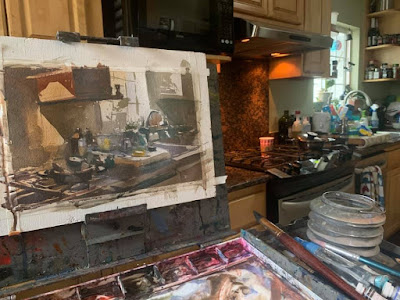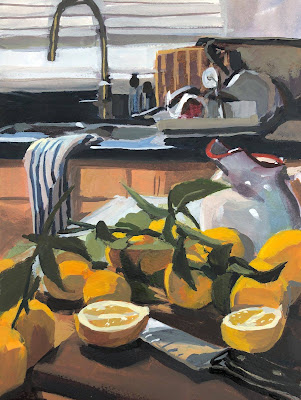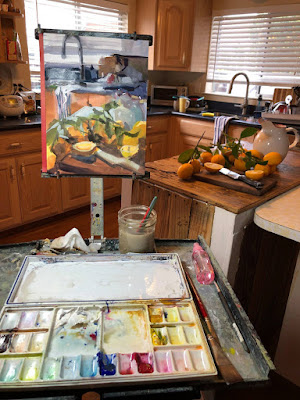A few weeks ago, I announced the "Paint a Kitchen Challenge,
" inviting you to paint a scene in your kitchen, or a commercial kitchen somewhere.
A lot of you took time from your busy schedule and brought your supplies into an active location with challenging lighting. There were both experienced painters and beginners, but you all deserve applause for your bravery and enthusiasm.
Because there were so many artistic and interesting results, it was hard to pick out the finalists, but here they are. Pentalic art supply company joined in to add some fun things to the prize packages.
Grand Prize Winner: Bhavani Krishnan
Bhavani's painting shows a family member pouring coffee, with an open dishwasher in the foreground. She's an experienced painter, and colors she used echo in endless beautiful variations throughout the picture.
She says: "Morning cuppa joe.. the usual morning routine in my kitchen.. gouache on moleskine sketchbook.. I used permanent yellow-orange, aliz crimson, turquoise blue, ultramarine blue and white."
-----
Shawn Fields
Shawn captured a magical feeling of kids working in the kitchen. There's beautiful atmosphere with this one, and this is a picture the family will treasure.
Palette: cadmium scarlet, cadmium yellow light, manganese blue hue, ivory black, titanium white.
------
Ada Alexander
Ada captured a variety of surfaces: tile, stainless steel, formica, and enamel, all with a limited palette.
She says: "I've been following James Gurney's painting from life challenges for a while, but it's the first time I plucked up the courage to actually do it :) It was challenging, but I've learnt a few things from it, so I am really happy I did it. It was also nice to go back to painting in gouache, which I haven't used in a while (in favour of watercolors). For this painting I used Yellow Ochre, Vermilion Red Light, Ultramarine Blue, Black and White."
Justin Pastores

You can see at a glance that Justin has a lot of painting experience, with a relaxed touch and a fine ability to suggest mood and atmosphere.
Details: "7:30-9:00am Size: 7x10 Medium: Watercolor Colors: Cobalt turquoise, Lavender, New gamboge, Pyrrol orange, Titanium white.
------
Heather Martin


Heather undertook a complicated scene with lots of overlapping. The painting leads my eye through layers and layers of space and detail.
She says: "Our yard is always overflowing with juicy lemons at this time, and this year was no exception. I decided to hack away at some of the thorny branches to add some color to our kitchen on the overcast winter day. Colors used: Titanium White, Ultramarine Blue, Yellow Medium, Burnt Umber, and Quinacridone Red. Da Vinci gouache was new to me, but impressed me with a thicker paint feel. Thank you for the challenge!"
----
Zoungy Kligge
Very nice sense of light under the vent hood of the range, contrasted with the cool window light on both sides.
"This is a painting of my mother's kitchen "in action." I had considered adding her from photo reference but decided to just do the kitchen from life. In total I spent a few hours on this, maybe about 1/4 time on the drawing and 3/4 on the painting. My materials are Holbein gouache in a Pentalic 5 x 8 watercolor journal, plus Caran D'Ache Supracolor pencils. I did the initial value lay-in with the pencils and some water and used a white pencil for the steam effect. My paint pigments were Permanent White, Burnt Umber, Burnt Sienna, Yellow Ochre, and Ultramarine. I accidentally photographed a Black paint tube instead of Ochre, but any black in the painting was made with Ultramarine and Umber mixed together, not Black pigment. My "easel" is yet to be built, so I experimented, first with holding my sketchbook and paint thumb palette only, and finally settled on holding a baking sheet, with everything I need on it. I hope you all enjoy the painting. Oh-- it gave me an excuse to break in my first Pentalic sketchbook which I'd been saving for some special occasion. This was the one."
----
Tim Hodge
Tim set up his sketchbook right next to the pizzas and captured the unique ovens in the kitchen.
He says the art is "5x8” in my sketchbook. I went to a local pizza shop and sat at the bar that looks into the kitchen and wood burning ovens. My palette consisted of burnt umber, ultramarine blue, spectrum red, permanent yellow deep and white. Oh, and the pizza was great, too!
----
Finalists, please email me your mailing address so that I can send you the embroidered patch, and I'll let Pentalic know so that they can send you the art goodies.
Thanks to everyone for participating. If you do Facebook, please see all the results of the "
Paint a Kitchen Challenge" on the special Facebook Event Page, and it would be great if you could add a like and a comment there.
 (On Amazon)
(On Amazon)












 The painted figures are approximately life size. The large canvas held vertically with the subjects' head in the painting close to Sargent's line of sight.
The painted figures are approximately life size. The large canvas held vertically with the subjects' head in the painting close to Sargent's line of sight.